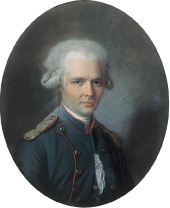Pierre Choderlos de Laclos facts for kids
Quick facts for kids
Pierre Choderlos de Laclos
|
|
|---|---|

Portrait attributed to Alexander Kucharsky
|
|
| Born | Pierre Ambroise François Choderlos de Laclos 18 October 1741 Amiens, Picardy, Kingdom of France |
| Died | 5 September 1803 (aged 61) Taranto, Kingdom of the Two Sicilies |
| Occupation | Writer, official and army general |
| Nationality | French |
Pierre Ambroise François Choderlos de Laclos (18 October 1741 – 5 September 1803) was a French writer, government official, and army general. He is most famous for his novel Les Liaisons dangereuses (Dangerous Liaisons), which came out in 1782.
Laclos was a unique figure in French literature. He was a military officer who also loved to write. His goal was to create a book that would be different and remembered long after he was gone. He certainly achieved this with Les Liaisons dangereuses. This book is considered one of the most important novels of the 18th century. It explores the relationships and power struggles among the wealthy people of that time. The novel has inspired many discussions, plays, and movies.
Contents
Biography
Early Life and Military Career
Pierre Choderlos de Laclos was born in Amiens, France, into a middle-class family. In 1760, he started studying at a military school. After finishing his studies, he became a young lieutenant. He served in different garrisons (military bases) across France. These included places like La Rochelle, Strasbourg, Grenoble, and Besançon.
In 1763, Laclos also joined a group called the Freemasons. He was promoted to captain in 1771. However, he found his army duties quite boring. He started using his free time to write.
First Writings and Les Liaisons dangereuses
Laclos's first writings were some short poems. These were published in a magazine called Almanach des Muses. He also wrote the story for an opera called Ernestine. It was based on a novel by another writer, Marie Jeanne Riccoboni. The opera was performed in 1777, but it was not a success.
In 1777, Laclos helped set up a new artillery school in Valence. Years later, Napoleon Bonaparte would be one of its students. Back in Besançon in 1778, Laclos was promoted again. During this time, he wrote works that showed his great respect for the philosopher Jean-Jacques Rousseau.
Laclos continued his involvement with the Freemasons. In 1777, he gave a speech where he encouraged women to be allowed to join the group.
In 1779, he was sent to Île-d'Aix to help build forts. But he spent most of his time writing his new novel, Les Liaisons dangereuses. This book is an epistolary novel, which means it is told through a series of letters. He took a break and went to Paris to finish writing it.
Success and Later Life
The book Les Liaisons Dangereuses was published on 23 March 1782. It was a huge success, selling 1,000 copies in just one month. This was very impressive for that time. After the book's success, Laclos was ordered back to his military duties.
In 1783, he was sent to La Rochelle to help build a new arsenal. There, he met Marie-Soulange Duperré. They got married on 3 May 1786 and stayed together for the rest of his life. The next year, he started a project to number the streets of Paris.
In 1788, Laclos left the army. He began working for Louis Philippe, Duke of Orléans. When the French Revolution started in 1789, Laclos became very active in politics. He supported the ideals of the Revolution. He later became a commissioner in the Ministry of War. His work helped reorganize the French army. This played a part in the French army's victory at the Battle of Valmy in 1792.
However, he was later arrested in 1793. He was freed in 1794. After this, he spent time studying ballistics, which is the science of how projectiles move. His studies led him to invent the modern artillery shell.
In 1799, Laclos met the young general Napoleon Bonaparte. He joined Napoleon's side. On 16 January 1800, he was put back into the army as a Brigadier General. He took part in the Battle of Biberach in 1800.
Death and Burial
In 1803, Laclos was made commander of the Reserve Artillery in Italy. He died shortly after in Taranto, Italy. He likely died from illnesses like dysentery and malaria.
He was buried in a fort near Taranto that he had helped build. After the old royal family returned to power in southern Italy in 1815, his burial tomb was destroyed. It is believed that his bones were thrown into the sea.
See also
 In Spanish: Pierre Choderlos de Laclos para niños
In Spanish: Pierre Choderlos de Laclos para niños

